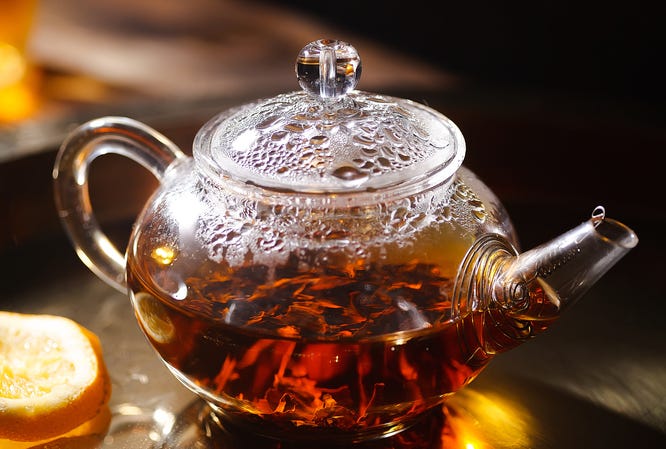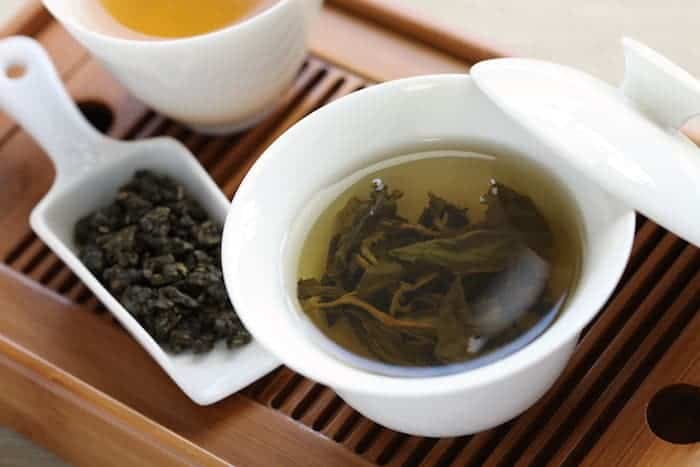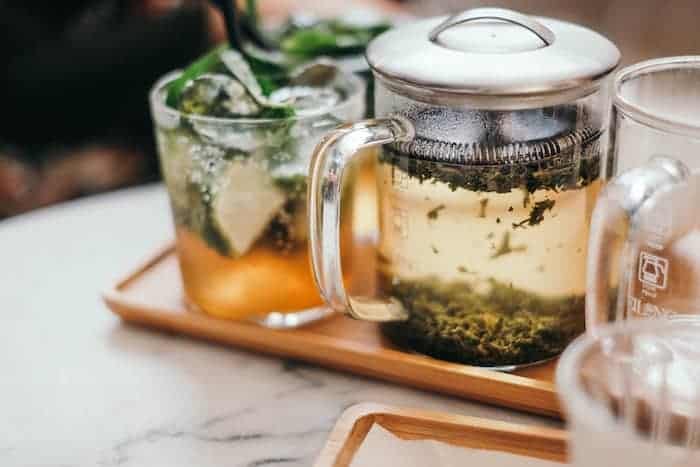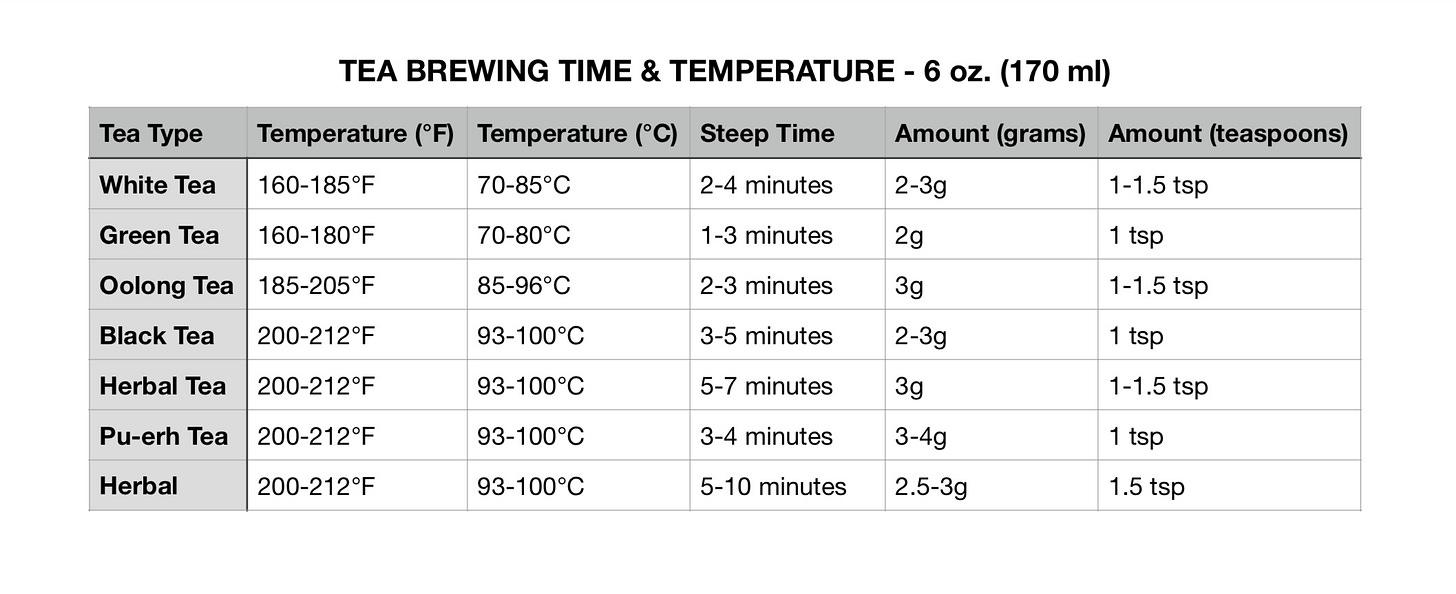How to Brew Tea Perfectly Every Time
Are you new to loose-leaf tea? A guide to brewing tea for beginners and experienced tea makers alike for the best cup of tea.
This guide is for transitioning from tea bags to making tea with loose-leaf tea. I’m still learning to make different teas, and I’ve been brewing tea my entire life. I’m not saying exactly how many years that is, but it’s safe to say it’s many!
It may be heartening to learn that tea masters in some Asian cultures study for years to perfect the art of brewing tea. There's a reason they study for a lifetime — tea mastery is a revered art form.
But honestly, it won't take you a lifetime to learn how to make a perfect cup of tea from fresh tea leaves. You just need to know a few basics.
Empty your cup: The benefits of a beginner’s mind
Poor tea preparation techniques and preconceived notions of making tea properly are the most common causes of disappointing tea. A famous Zen saying asserts that to learn, you must “first empty your cup.” The story is attributed to a conversation between a student and a Zen master.
The lesson begins with the master pouring tea into the student’s cup. Instead of stopping when the cup was full, he continued to pour as tea spilled over the teacup and all over the table.
The student shouted, “Stop! The cup is full!”
“Exactly,” said the Zen master. “Like this cup, you are full of your own opinions. You ask for teaching, but your cup is full. Before I can teach you, you must first empty your cup.”
If you truly seek understanding, then first, empty your cup.
Of course, this is a metaphor for life. It applies not only to learning new ways to make tea but to learning in general. If you already think you know the answer, you will never open your mind to learning new things. A closed or “full” mind is an ignorant mind. And by ignorance, I don’t mean unintelligent, but lacking openness to consider alternate viewpoints.
Brewing loose-leaf tea is an entirely different experience than brewing tea from tea bags. So, even if you think you know how to brew tea, you may have something to learn when brewing loose-leaf tea.
How to make loose-leaf tea
To begin, follow these basic steps. The amount of tea used depends on the tea brewing style (Eastern vs. Western) used to brew tea from the Camellia sinensis leaf. Herbal teas generally follow Western brewing methods, although some will call for simmering instead of steeping.
First, warm the teapot and cups. Pour hot water in, swirl around, and pour it out, which helps keep the finished brew hot.
Use freshly drawn filtered water.
Do not use reheated water.
Pour hot water over the tea leaves to stir them up.
Water temperature, the volume of tea leaves, and steeping time are all part of the art of brewing tea. Depending on the water temperature and steeping time, different compounds are extracted.
Gongfu (Eastern) brewing vs English (Western) brewing
Gongfu brewing uses a large tea leaf-to-water ratio with short infusion times. Green and scented teas are not utilized in gongfu-style brewing. This method is for brewing black and oolong teas.
The teaware used for the gongfu brewing is a small vessel like this beautiful Gaiwan or a small teapot. The idea is to produce short multiple infusions, extracting different flavors from the leaf with each subsequent infusion. You will brew multiple tea infusions in one gongfu tea session.
Western-style tea brewing, or English-style, as some call it, uses much less leaf and more water and has longer brewing times. Western tea brewing extracts as much flavor as possible all at once.
Brewing tea in a teapot
The easiest way to make loose-leaf tea is by brewing in a teapot. It's best to brew tea in a teapot or a mug that has a large tea infuser. This way, you can stop the steeping process and easily remove the leaves before pouring. Teapots and tea infusers for loose tea are readily available at any good tea shop or Amazon.
Try not to use the small ball infuser for whole-leaf teas. The tea leaves won't have room to expand and infuse their full flavor. A French press works very well for brewing loose-leaf tea.
My Wedgwood English-style teapot shown above has holes inside the base of the spout to catch the tea leaves as you pour. This treasured teapot is at least 60 years old - it may be older! It's such a beautiful and perfectly shaped design that Wedgwood still makes this teapot style today in different patterns.
The Perfect Teapot
Rishi makes a beautiful little glass Simple Brew Teapot, as shown here. It's made of borosilicate glass to avoid thermal shock. The glass pot allows you to watch your tea infuse, and the built-in filter keeps all of your tea in the pot for future steeping. I especially like it for brewing herbal teas and use mine every night to brew chamomile or other herbal teas.
How to brew tea without tea bags
Brewing tea extracts flavors and nutrients inherent in the tea leaves through various steeping methods, creating an infusion. Everyone gets tripped up when they hear “various steeping methods.” The truth is, even standard brewing methods can vary with each specific tea and with each person.
Part of the joy of tea is learning about different cultures and ways of brewing tea. Should I brew English style in a teapot or mug? Perhaps I want to make a concentrate and brew it with a samovar, a powdered tea with a Japanese bamboo whisk, or Chinese gongfu style.
The choice is yours. There’s no right or wrong. But you can follow some general guidelines to help you brew a better cup of tea.
Water for brewing tea
Good water is as essential for brewing tea as the tea itself. Spring water is ideal for this purpose. Tea is delicate and can be affected by water that has a mineral count or chlorine content that is too high.
Most municipal waters fall into this category. The best way around this is to use a good water filter. I used a simple Brita filter for years. A Pur filter also eliminates chlorine and reduces the high mineral content. On the other hand, soft or distilled water has little to no mineral content, leaving the brewed tea tasting flat. Some minerals are good.
If you use well water, be aware of the pH level. Some well waters have a very high pH count; ideally, you want a neutral pH as close to 7.0 as possible.
I learned this one the hard way. My first co-packer for producing MaryAnna's bottled tea was in upstate New York. They only had well water, and we couldn't adjust the pH for safe bottling, so we had to buy hundreds of gallons of spring water to complete the production run!
Minerals in water are measured as Total Dissolved Solids (TDS). The ideal TDS is 100 - 300 parts per million (PPM). When purchasing spring water, look for a pH of 7.0 and TDS of 300 PPM. TDS is sometimes measured in milligrams per liter. If that's the measurement used, below 300 mg/l is excellent.
Water temperature and tea brewing times
Green teas do better with shorter infusion times and much lower water temperatures. The first mistake most green tea drinkers make is using boiling water, which quickly turns the tea bitter. This applies to matcha green tea as well. Most green teas and greener oolong teas taste best when brewed at temperatures 30° — 40° F below boiling point, bringing them to 180° — 170°F.
Are You Curious About Matcha Tea?
Water temperatures at or just below boiling (212°F) are ideal for black and oolong teas. Green tea is more delicate and requires a milder temperature. The proper water temperature for the specific tea type will yield the desired characteristic flavors.
If you want to be precise, there are some excellent kettles with built-in thermometers for steeping tea. I like the Bonavita or the Cuisinart model because they have variable temperatures and elegant designs.
I use a stovetop kettle and this simple method of boiling the water and then letting it sit for five minutes. The approximate temperature will drop to the desired 180° F in that time.
The tea type determines the volume
The leaf's size helps determine the brewing time and the amount of tea used.
Smaller cut leaves have more surface area and will infuse faster, requiring a shorter steeping time and smaller amounts of tea per cup.
A larger leaf size requires a larger leaf volume and longer steeping times.
For best results, measure volume in weight instead of teaspoons: 2 - 2.5 grams for a 6-ounce cup is ideal. A large full-leaf tea at 2 grams of weight may be much larger than one teaspoon in volume. A digital kitchen scale comes in handy.
The art of tea considers all of this and helps you determine the precise time, volume, and temperature at which your tea provides your favorite aromas and flavors.
Don’t stress about this! Experiment and have fun with it. Start with this guide, but in the end, making tea is all about how you like it.
Tea brewing guide
In its simplest form, brewing tea has five main components: method, water, temperature, time, and type of tea. The brewing guide below is for the Western style of brewing tea. All teas lend themselves well to this style of brewing.
Note: Water boils at a lower temperature at higher altitudes, so adjust your temperatures accordingly.
Or you can watch how my favorite Brit, Maggie Smith, makes tea!
When to add flavorings to tea
Adding any flavorings or enhancements is optional. Just be mindful of the taste profile of the tea.
Honey, sugar, or mint can be added to black or green teas. Lemon, lime, or other fruits can be added to black teas and some green teas. Milk should only be added to strong black tea.
Other teas, such as oolongs, smoked, or floral-scented teas, usually don’t need enhancements.
When to break tea brewing rules
I use a strong brew when mixing tea-inspired drinks or cooking with tea. I will also tell you another secret — you need a strong mixture when you make iced tea.
When the tea is cold, as in iced tea or a tea cocktail, the flavor does not come through as much. So, you must have a stronger-than-usual brew. The same goes for cooking with tea.
You want to taste the tea, which must be evident in the food or drink. Each tea has its flavor and fragrance. Let it come through, but do not overpower the recipe.
The tea you select should be harmonious with the ingredients used in cooking or mixing cocktails and iced teas. The tea should maintain its identity while enhancing the recipe.
The trick to making a strong brew is not by steeping longer. The secret is to use more tea leaves.
There's no set rule. These guidelines will help you figure out the best way to make tea without teabags. Start by following the tea vendor's guide on the package and brewing your tea to your taste.
Now that you know how to make tea from tea leaves, you'll be able to explore a whole new world of tea!
❤️ ❤️ Let me know if you enjoyed this guide by giving the heart a little tap!









good tea tips and I love the wedgewood teapot a cup...
Love this! I’m Harrison, an ex fine dining industry line cook. My stack "The Secret Ingredient" adapts hit restaurant recipes (mostly NYC and L.A.) for easy home cooking.
check us out:
https://thesecretingredient.substack.com